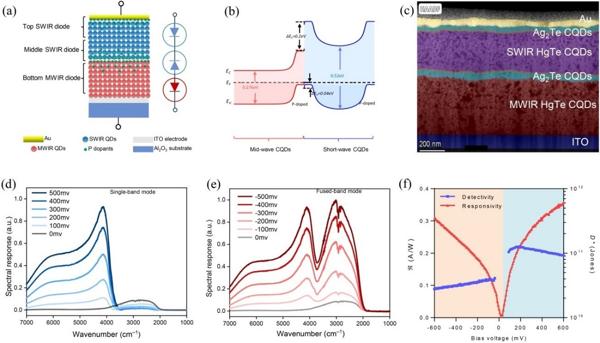Going beyond human vision capability, infrared can provide objects' important information such as molecular composition and thermal distribution. Because of its characteristics different from visible light, infrared detectors are widely used in night vision, reconnaissance, aerospace, astronomy, weather prediction, health detection, security, environmental monitoring and other scenes.
With the rapid development of infrared detection technology, multi-color detection has become one of the important directions of the new generation of infrared detectors. For better target recognition and identification, there are strong demands for combining images from different spectral bands, which is also known as spectral image fusion technology. This image from fused spectral bands can provide a more accurate understanding of the surrounding information compared to single spectral data.
The simple solution to build a photodetector with fusion imaging capability would be an imager which responds to distinct spectral ranges and fuse signal on the pixel level. However, the spectral sensing ranges of imagers are mainly defined by their materials (eg. , Si for 0.4-0.7µm@visible, InGaAs for 1.5-1.7 µm@short-wave infrared, and HgCdTe for 3-12 µm@mid-infrared) and combination of different materials into the same pixel vertically or horizontally is hindered by the lattice mismatch and incompatibility between fabrication processes. The existing fusion imagers uses detectors in different bands to collect information of each band respectively, and synthesize fusion images in the later stage. Despite continuous efforts on sophisticated fusion algorithms, registration error inevitably presents due to the mismatch of pixel size, array size, and optical imaging axis between separate imagers.
To address the problems, a research group led by Prof. Xin Tang, Prof. Menglu Chen, and Prof. Qun Hao at the Beijing institute of technology, develops a colloidal quantum-dot dual-mode detector capable of detecting, separating and fusing photons from various wavelength ranges based on mercury telluride colloidal quantum dots. Using three vertically stacked colloidal quantum-dot homojunctions with alternating polarity, single-band short-wave infrared imaging and fused-band imaging (short-wave and mid-wave infrared) can be achieved with the same detector by controlling bias polarity and magnitude.
The reported approach is based on solution-process colloidal quantum dots to solve the lattice matching between different bandgap materials. Through the carefully designed band engineering, single-band short-wave infrared imaging and fused-band imaging (short-wave and mid-wave infrared) can be achieved at the pixel level. The relevant research results were published in Photonics Research, Volume 10, No. 8, 2022 (Shuo Zhang, Ge Mu, Jie Cao, Yuning Luo, Qun Hao, Menglu Chen, Yimei Tan, Pengfei Zhao, and Xin Tang, Single-/fused-band dual-mode mid-infrared imaging with colloidal quantum-dot triple-junctions[J]. Photonics Research, 2022, 10(8): 1987).
Fig.1 (a)-(c) shows the illustration, simulated energy band diagram and cross-sectional transmission electron microscopy image of the detector. The device structure design does not require precise photocurrent balance between multiple diodes, and the carriers generated in one CQDs diode, as driven by built-in potentials, can move freely to the other side and be collected, favored by the addition of a middle p-doping layer.

Fig.1 (a) Illustration of dual-mode colloidal quantum-dot Photodetectors and equivalent circuits of triple-junction structure. (b)Simulated energy band diagram of dual-mode triple-junction photodetectors. (c) Cross-sectional transmission electron microscopy image of the dual-mode detectors. Bias-dependent spectral response under (d) positive and (e) negative bias voltages. (f) Bias-dependent responsivity and detectivity of a dual-mode photodetector.
The results show that the detectors indeed showed bias-tunable dual-mode photoresponse performance (Fig.1 (d) and (e)). The dual-mode detectors show detectivity up to 4×1010 Jones @ fused-band mode and 1.5×1011 Jones @ single-band mode, respectively (Fig.1 (f)). By fusing information on detector level, fused images without registration error can be achieved which is great advantages over current image fusion methods with separate imagers.
Without post processing or image algorithms, the dual-mode detectors could provide both night vision and thermal information-enhanced night vision imaging capability. To the best of our knowledge, this is the first colloidal quantum-dot detector that can achieve such functionality. The operation mode can be changed at high frequency up to 1.7 MHz, making it possible to achieve simultaneously dual-mode imaging and remote temperature sensing.It shows the potential of colloid quantum dot technology in developing the next generation of infrared imagers.


